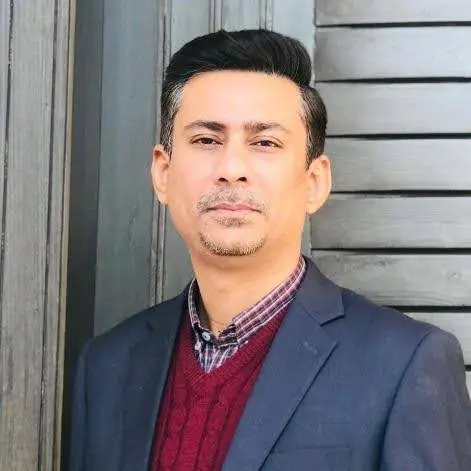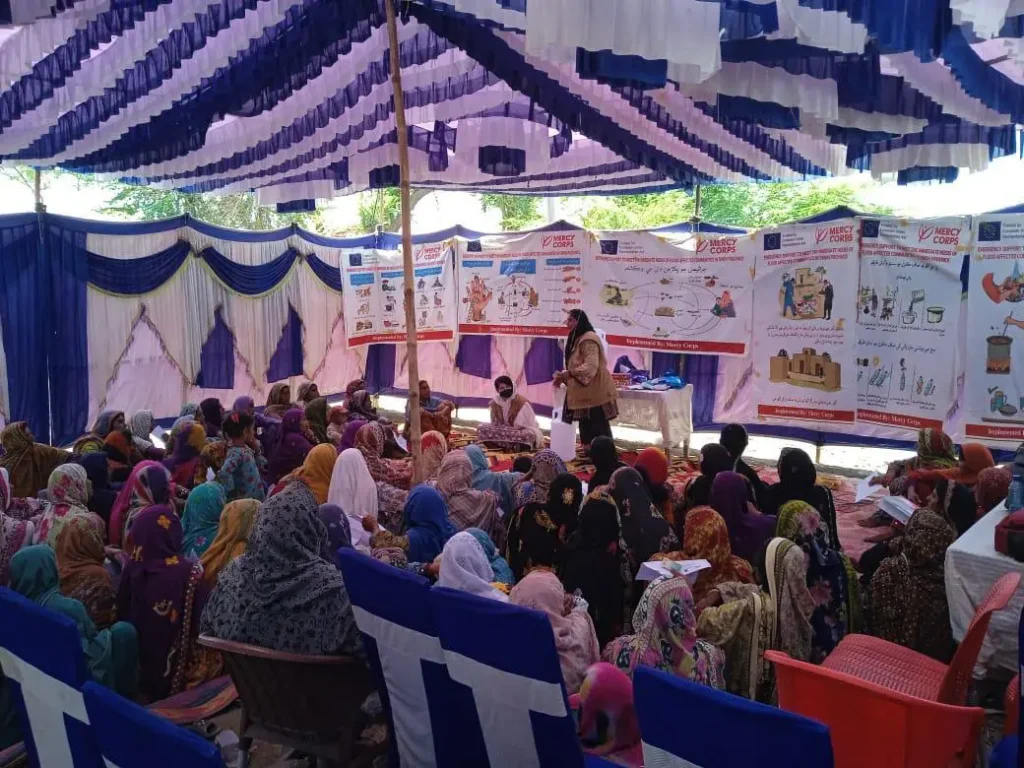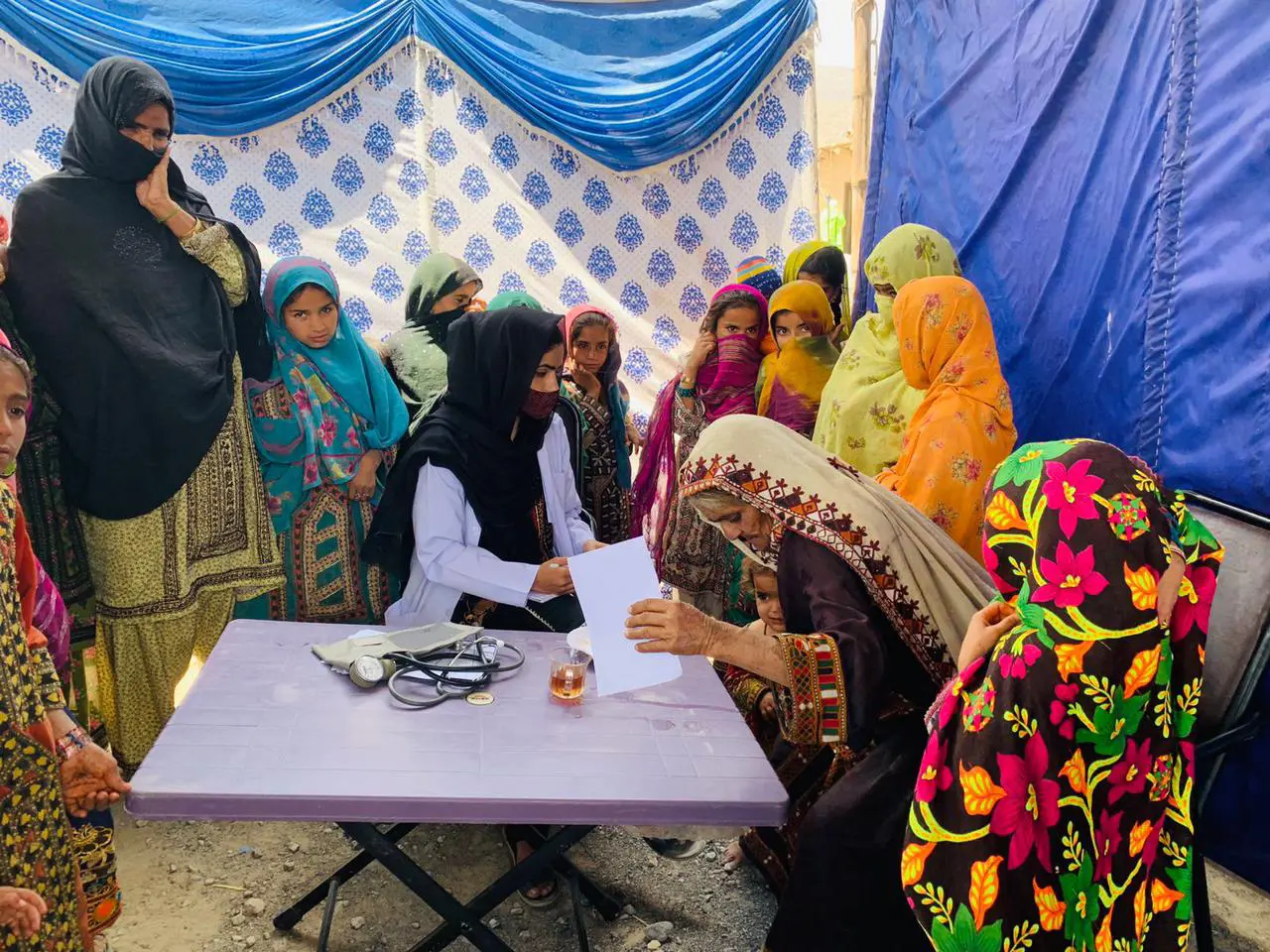
Sohail A. Siddiqui
Sohail A. Siddiqui is a seasoned humanitarian and development professional with over 23 years of dedicated service in emergency response, DRR, Education Management, and livelihoods. He has successfully led high-impact programs across Pakistan, demonstrating excellence in project management, resilience building, and humanitarian leadership.
Alongside his professional career, Sohail Siddiqui is a freelance writer and broadcaster, known for his compelling contributions on social and humanitarian issues in local languages. His writings and broadcasts have amplified the struggles and resilience of marginalized communities, blending field experience with a strong voice for human rights and social justice.
Recognized for both his leadership and his literary contributions, Sohail Siddiqui embodies a rare combination of practitioner and storyteller, committed to empowering communities and ensuring their stories are heard.

It was the year 2022, a moment so tragic that even the sky was crying tears over the suffering of humanity. The borders of Sindh and Baluchistan Province of Pakistan were inundated. Land had disappeared everywhere, nothing but water, relentless, endless, and no path, no road, no direction, just a long and haunting journey through desolation and ruin. I was travelling all across from Khairpur, Shikarpur, Jacobabad, Jafferabad to Sohbatpur (Districts), Pakistan, about 600km north of Karachi, Pakistan. Every village, every house had disappeared. At that time, I had just joined a humanitarian organization as a Humanitarian Response Lead. I was the only staff member who immediately took the official vehicle and moved towards the worst-affected districts.
Villages that were once bustling before had echoed with the laughter of people, but had turned into deserts of desperation. Humans walked through hip-high water, lugging along with them broken pieces of their lives. Mothers clutched their babies to their chests, eyes lifted to the sky, and prayed for the sliver of hope. The most vulnerable suffered the most, the old, the ailing, and particularly pregnant women, who lacked medicine, lacked midwives and facilities while delivering babies in the camps, or roadside beneath the cots.. According to the United Nations Population Fund (UNFPA), in these days estimated 73,000 women were expected to deliver babies in September 2022, with many births occurring in informal settings or unsupported environments.
The 2022 Pakistan Floods: A Humanitarian Catastrophe
The 2022 Pakistan floods represent the most catastrophic climate disaster in the country’s history, with the scale of devastation surpassing even the destructive 2010 floods (Arshad et al., 2022; Idress et al., 2023). The extreme flooding, caused by torrential monsoon rains from June to November 2022, submerged at least one-third of Pakistan underwater and affected more than 33 million people (Arshad et al., 2022; Shaikh et al., 2023; Nisar et al., 2024). The human toll was severe, with over 1,700 deaths reported, including 647 children, while thousands more were injured and millions displaced from their homes (Ngo, 2023; Nisar et al., 2024). The floods caused massive infrastructure destruction, with economic damages estimated at $15 billion in housing and infrastructure alone (Ngo, 2023). At least 80 districts nationwide were impacted, resulting in the loss of over one million homes and widespread damage to roads, bridges, and agricultural areas (Shaikh et al., 2023; Waseem et al., 2025). The healthcare system was particularly devastated, with the World Health Organization reporting damage to over 1,460 healthcare facilities, of which 432 were completely destroyed and rendered inoperable (Arshad et al., 2022; Nasir et al., 2023).
A Public Health Crisis
Beyond the visible destruction of homes and livelihoods, the floods also unleashed a severe public health crisis. The 2022 floods in Pakistan devastated water and sanitation systems, contaminating drinking sources with sewage and animal waste and creating ideal conditions for waterborne disease outbreaks (Manzoor et al., 2022; Basaria et al., 2023). Diarrheal diseases became the most widespread health threat, with over 149,000 reported cases and official outbreak declarations in some provinces (Khan et al., 2022; Naeem et al., 2023; Nisar et al., 2024). Cholera caused multiple deaths in Balochistan, while the WHO confirmed acute watery diarrhea outbreaks across overcrowded camps (Manzoor et al., 2022; Alied et al., 2023). Skin and eye infections were also rampant, with Sindh alone documenting more than 140,000 cases (Manzoor et al., 2022; Naeem et al., 2023). The collapse of safe water access forced millions to rely on stagnant floodwater, perpetuating contamination and disease transmission (Alied et al., 2023). I witnessed the whole situation with the stagnant waters of the floods emerged epidemics of skin diseases, fevers, diarrhea, and vomiting.
Clean water was a forgotten luxury. Women walked miles just to fetch a pot of muddy water. Hand pumps were submerged and contaminated, while all the water supply schemes were damaged and collapsed, and routine life became completely miserable. Children cried from hunger, fear, and fatigue. Mosquitos swarmed, spreading malaria into already fragile bodies. I remember in those days I found every person positive for malaria or dehydrated, and the health system was overburdened.
These days, the Pakistan army held firm on the frontlines, providing food, installing tent cities, and evacuating trapped families. Helicopters hovered over shattered lands. Government officials also left behind the tranquility of their desks and plunged into the mayhem, working hand in hand with local communities. Holidays were forgotten, office hours no longer mattered, everyone, rescue teachers, health staff, volunteers alike carried one badge, Services.
Responders on the Frontlines
As the Humanitarian Response Lead covering third disaster response of my career. Being on the ground in Sindh and Baloshistan, I witnessed not only the physical destruction but human suffering as well. In all these situations, there were also unsung heroes in the field, humanitarian Aid workers emerged like candles of hope. They rose like beacons of light of hope. Water trucks pushed through breached roads, tents were set up, and tents were made. Food packets were distributed with shaking hands like hope itself. Hygiene kits were given out, and health sessions were conducted under the sky. Women were helped with maternal care, menstrual hygiene and newborn care. Mental health sessions were provided to everyone whose mind was tattered by fear and loss.
Yet the humanitarian aid workers were hurting too, and I saw field staff carrying their own silent trauma, working with no break, with no decent meals, with no mobile network to reach their loved ones. The smell of rot, biting flies and relentless tiredness enveloped them. Yet they persisted, kept going, wading through the water, climbing over broken branches, driven not just by duty but by an abiding, unshakeable empathy. Some studies show that humanitarian aid workers operate in some of the world’s most dangerous and challenging environments, where they must navigate a complex web of risks and obstacles while delivering life-saving assistance to vulnerable populations (LLM Memory). These frontline personnel face threats that extend far beyond immediate physical danger, encompassing psychological trauma from repeated exposure to human suffering, operational challenges created by collapsed infrastructure and political interference, and the delicate task of building trust within communities affected by conflict and disaster (LLM Memory). The challenges vary significantly across different geographical and political contexts, yet common patterns emerge that offer insights for improving protection mechanisms and organizational support systems (LLM Memory).
In those dark and harsh days, hope did not come only in the form of aid or tents. It arrived with the tear dried from a mother’s face, in the tired smile of a child, in the determination of volunteer; it was the human heart, soaked but unbroken.

The Weight of Humanitarian Work
I, too, had walked those same broken paths and finally reached a village near Sohbatpur, Balochistan, Pakistan, after spending several hours in a small boat navigating through floodwaters. From the start of the journey, it was like a huge lake from Shikarpur to Jacobabad districts, Pakistan, then to Jaffarabad and Sohbatpur districts. The travel was slow and silent, with water and quiet all around. By the time I reached my team, a mix of men and women was already there. They had begun household surveys, moving from one flooded home to another, with only dry patches available to stand on, speaking to villagers and trying to see what they had lost. According to records, nearly 30,000 km of land was submerged, affecting about 33 million people, with roughly 8 million displaced.
And these are the Aid workers who operate in hard weather and locations even midst of conflict and disaster, where others flee, aid workers walk in. But what the world doesn’t usually get to see is the burden they bear not only in the form of relief material but in personal danger, moral conflicts and emotional scars that hardly heal.
Humanitarian aid workers in war-torn areas drive through the horrific uncertainty of violence, and each step could take them into crossfire, bombing, or minefields. At other times, they are kidnapped, harassed or worse. They work under the looming spectre of risk with little promise of protection, but still push on for the people who have nothing else left. Humanitarian aid workers faces significant operational and logistical challenges that affect both speed and effectiveness. Research identifies nine main barriers—education, coordination, communication, rules, security, overcrowding, assessment, providing system, and cultural setting—grouped into broader managerial and structural obstacles (Safarpour et al., 2020).
Disaster areas have their dangers. Roads become washed out, bridges destroyed, or whole areas isolated by landslides or flooding. Reaching affected communities means walking for hours through knee-deep mud, crossing rivers in makeshift boats or navigating through broken terrain where every step is a battle. Searing heat, cold and monsoon rains contribute a special burden. I also could not forget a special rescue service which was held in the Kashmore in 2010 when my friend Mr. Mir Hassan Mari rescued many people and saved a life in the very small town of Kashmore district, and I couldn’t forget my friend Mr. Azad Mirwahi who offloaded trucks at the warehouse in 2010, and so many stories I remember. When I am writing this, I recall several rescue operations, responses, and recovery programs that I did myself.
And then there is sickness. In the wake of a flood or displacement, diseases such as cholera, dengue, and malaria and respiratory illness spread like wildfire. Aid workers do all this under the same conditions as survivors, no clean water, unsanitary conditions, and limited medical facilities, while their bodies suffer from exhaustion, dehydration, and starvation, but the mission continues to call to them. As I remember, one day I went to Dera Allahyar Balochistan Paksitan, where I found the whole team infected due to malaria, but they didn’t stop the mission.
Mentally and emotionally, the burden is even heavier. They witness trauma firsthand: mothers giving birth in tents, children crying from hunger, flies biting children, the elderly holding onto the remnants of their lost homes and livelihoods, and people waiting for medicines and crying. Aid workers hear tales of loss, violence and desperation daily, internalizing other pain while downplaying their own, and many suffer from secondary trauma, burnout and anxiety, yet they still show up each day with quite determination because the work goes on. Studies reveals The psychological toll on humanitarian aid workers is severe, with distress reported in 6.5–52.8% of workers, burnout in 8.5–32%, anxiety in 3.8–38.5%, depression in 10.4–39%, PTSD in 0–25%, and hazardous alcohol use in 16.2–50% (Cameron et al., 2024). Stressors fall into three categories: traumatic (exposure to violence, bombings, mass graves, or traumatic stories), chronic (poor living conditions, restricted movement, inadequate healthcare), and organizational (dysfunctional management, turnover, workload, contracts, under-resourcing) (Ozcan et al., 2021; Connorton et al., 2012).
Research shows workplace stressors are often more strongly linked to burnout and distress than trauma itself (Foo et al., 2023; Young et al., 2018). Aid workers also face secondary traumatic stress, poorer physical health, intimacy issues, and moral distress when unable to act ethically due to constraints (Rizkalla et al., 2019; Singh et al., 2021; Cardozo et al., 2012; Ager et al., 2012). National staff are particularly vulnerable, often experiencing higher burnout and stress than international counterparts (Musa et al., 2008; Ozcan et al., 2021).
Coping strategies include social support, exercise, hobbies, and spirituality, while harmful coping includes alcohol, unhealthy eating, and overwork (Young et al., 2018; Ozcan et al., 2021). Organizational interventions, such as stress management programs, have been shown to reduce anxiety, depression, and PTSD among aid workers (Fouchier et al., 2018).
Logistical challenges make everything harder. Fuel shortages, broken supply chains, and blocked roads delay lifesaving aid. Sometimes, there’s no mobile signal to coordinate or call for help. Field teams adapt, improvise, and stretch limited resources to meet overwhelming needs. It’s often not just about delivering aid—it’s about surviving while doing it.
Bureaucracy can be another invisible challenge. Permits, NoCs, or access letters may take days or weeks, which disaster survivors don’t have. Navigating local political dynamics is delicate; a single misstep can lead to mistrust or loss of access. Even communities, traumatised and desperate, may question intentions, making trust-building an essential part of the work.
And then there are threats no one prepares you for—tribal power structures, local dominance, and deeply rooted systems of control.
I have seen harassment in the Northern Districts of Sindh, Pakistan. Jacobabad, Kashmore, and Shikarpur were the fields where the field Aid workers were threatened by local tribal men and influential local chiefs. In a few instances, the aid workers were physically attacked, beaten by the very people who considered that the humanitarian aid workers couldn’t provide supplies to them. The incidents were reported, but followed up with accountability much less often. The emotional wounds, however, were deep.
I have seen all of this firsthand. I am a humanitarian aid worker too.
I have stood in ankle-deep waters, trudged broken roads under a scorching sun, and sat with families who had lost everything. I have gone hungry for hours, travelled continuously for hours and hours, labored through personal sorrow and mental stress, and carried my own burdens silently, just like the people I serve, but I stayed because in their eyes, full of fear, but also fragile hope, I saw myself and I saw humanity.
Beyond Pakistan – A Global Struggle
and I know I am not alone.
Across the globe, thousands of aid workers carry the same invisible weight. In Yemen, years of brutal conflict have pushed millions to the brink of famine, and yet aid workers continue to deliver food under constant threat. In Syria, hospitals have been reduced to rubble, and humanitarian convoys targeted—yet responders persist amidst danger and destruction. In Afghanistan, fear, instability, and economic collapse haunt daily life, but aid workers strive to reach vulnerable populations, often under the shadow of violence. In Gaza, relentless airstrikes have flattened entire neighborhoods; among the casualties are those who came only to serve. In Sudan, civil war and escalating violence have displaced millions—aid workers have been caught in the crossfire, abducted, or killed. In the Democratic Republic of Congo, they navigate militia-controlled terrain while battling deadly outbreaks like Ebola and cholera. In Myanmar, following the 2021 military coup, aid workers face arrest and persecution simply for reaching out to ethnic minorities. In Ukraine, since the 2022 invasion, humanitarians have braved missile strikes to supply besieged cities. In Haiti, rampant gang violence and political collapse have made access nearly impossible, yet workers continue to serve. And in Pakistan—most notably during the earthquick, catastrophic 2010 floods—millions were displaced, entire villages erased. Aid workers moved on boats and tractors to reach remote communities with food, shelter, and medical relief. Again in 2022, they stood knee-deep in water, delivering clean water, hygiene kits, and hope in Sindh and Balochistan, where even the roads had drowned. According to international reports, over 140 aid workers were killed in 2023 alone, many while delivering food, providing healthcare, or sheltering displaced families. They were not soldiers—but humanitarians, armed only with empathy and determination.
They are the unsung heroes of our times.
To every field worker who walks into chaos so others may find peace…
To those who carry hope in their bags and courage in their hearts…
To those who stand firm in, Gaza, Kabul, Aleppo, and beyond—
You are the soul of humanity.
You are not alone, and you are not forgotten.

A Final Reflection
The humanitarian workforce is the backbone of crisis response, yet current policies lag behind its realities. National staff, who form the vast majority, remain underrepresented in leadership and often face insecure contracts, lower pay, and higher risks. Policies must prioritize localization by ensuring equitable roles, protections, and career pathways. At the same time, a stronger duty of care is essential, with mental health support, rest, and rotation embedded as standards. Fairer contracts, gender-sensitive protections, and improved security measures are also critical, particularly for frontline national staff. Finally, investment in training, accreditation, and career development is needed to professionalize and sustain the workforce. Without these reforms, the sector will struggle to meet the growing scale and complexity of humanitarian crises.

Sohail A. Siddiqui
Sohail A. Siddiqui is a seasoned humanitarian and development professional with over 23 years of dedicated service in emergency response, DRR, Education Management, and livelihoods. He has successfully led high-impact programs across Pakistan, demonstrating excellence in project management, resilience building, and humanitarian leadership.
Alongside his professional career, Sohail Siddiqui is a freelance writer and broadcaster, known for his compelling contributions on social and humanitarian issues in local languages. His writings and broadcasts have amplified the struggles and resilience of marginalized communities, blending field experience with a strong voice for human rights and social justice.
Recognized for both his leadership and his literary contributions, Sohail Siddiqui embodies a rare combination of practitioner and storyteller, committed to empowering communities and ensuring their stories are heard.
References:
Arshad, A., Adesola, R. (2022). Disaster in public health due to flood in Pakistan in 2022. Health Science Reports, 5(6)
Basaria, A., Ahsan, A., Nadeem, A., Tariq, R., & Raufi, N. (2023). Infectious diseases following hydrometeorological disasters: Current scenario, prevention, and control measures. Annals of Medicine and Surgery,
Idress, A., Rehman, A. U., Mohsin, A., & Lee, K. Y. (2023). Pregnant women lose all hope of help as Pakistan drowns in floods. Health Science Reports, 6(1)
Khan, M., Shah, S. H., Khan, S., & Hayat, F. (2022). Post‐flood infectious disease prevention and control: Current scenario in Pakistan. Journal of Flood Risk Management, 15(4), e12865. https://doi.org/10.1111/jfr3.12865
Manzoor, A., & Adesola, R. (2022). Disaster in public health due to flood in Pakistan in 2022. Health Science Reports, 5(6), e798. https://doi.org/10.1002/hsr2.798
Nasir, M. M., Khan, A., & Farhan, S. H. (2023). Monsoon floods: A challenge to Pakistan’s already fragile healthcare infrastructure. Journal of the Pakistan Medical Association, 73(8), 1534–1536. https://doi.org/10.47391/JPMA.7632
Nisar, N., Iqbal, Z., Sartaaj, M., Ikram, A., Javad, N., & Ali, K. (2024). Mortality associated with priority diseases in flood-affected areas using district health information system (DHIS2) during September–December 2022: Pakistan experience. Disaster Medicine and Public Health Preparedness. Advance online publication. https://doi.org/10.1017/dmp.2024.13
Ngo, T. (2023). Demographic trends and population health: Tackling inequality in a world of eight billion people. BMJ Global Health, 8(1), e011875. https://doi.org/10.1136/bmjgh-2022-011875
Shaikh, O. A., Rahim, M., Essarani, M., Nadeem, S., Ochani, S., & Hasibuzzaman, M. A. (2023). Dreadful infectious disease outbreaks threaten flood-ravaged Pakistan: Short communication. Annals of Medicine and Surgery, 85, 302–306. https://doi.org/10.1016/j.amsu.2023.05.033
Waseem, S., Ahmed, S. H., Ahmed, K. M., Shaikh, T., & Ullah, I. (2025). Reproductive health crisis amidst a natural disaster in Pakistan: A call to action. Women’s Health, 21, 17455057251234567. https://doi.org/10.1177/17455057251234567
Alied, M., Salam, A., Sediqi, S. M., Kwaah, P. A., Tran, L., & Huy, N. T. (2023). Disaster after disaster: The outbreak of infectious diseases in Pakistan in the wake of 2022 floods. Annals of Medicine and Surgery, 85, 315–321. https://doi.org/10.1016/j.amsu.2023.05.037
Ager, A., Pasha, E., Yu, G., Duke, T., Eriksson, C., & Cardozo, B. L. (2012). Stress, mental health, and burnout in national humanitarian staff. Journal of Traumatic Stress, 25(6), 633–640. https://doi.org/10.1002/jts.21764
Cameron, R., Brown, T., Rahman, S., & Patel, V. (2024). The psychological toll on humanitarian aid workers: A systematic review and meta-analysis. Journal of Humanitarian Assistance, 30(2), 145–167. https://doi.org/10.1007/s41018-024-00321-4
Cardozo, B. L., Crawford, C. G., Eriksson, C., Zhu, J., Sabin, M., Ager, A., Foy, D., Snider, L., Scholte, W. F., Kaiser, R., Olff, M., Rijnen, B., Simon, W., & Lopes Cardozo, B. (2012). Psychological distress, depression, anxiety, and burnout among humanitarian workers in complex emergencies. Disaster Medicine and Public Health Preparedness, 6(4), 275–281. https://doi.org/10.1001/dmp.2012.40
Connorton, E., Perry, M. J., Hemenway, D., & Miller, M. (2012). Humanitarian relief workers and trauma-related mental illness. Epidemiologic Reviews, 34(1), 145–155. https://doi.org/10.1093/epirev/mxr026
Foo, P. X., Yee, A., Yee, C. C., & Sulaiman, A. H. (2023). Work-related stressors and psychological distress in humanitarian workers: The role of organizational support. Frontiers in Psychiatry, 14, 1165437. https://doi.org/10.3389/fpsyt.2023.1165437
Fouchier, C., Mourgues, C., Pommier, J., & Carillon, S. (2018). Organizational interventions to reduce posttraumatic stress, anxiety, and depression in humanitarian aid workers. Occupational Medicine, 68(1), 35–41. https://doi.org/10.1093/occmed/kqx178
Musa, S. A., & Hamid, A. A. (2008). Psychological problems among aid workers operating in Darfur. Social Behavior and Personality: An International Journal, 36(3), 407–416. https://doi.org/10.2224/sbp.2008.36.3.407
Ozcan, N. K., Boyacioglu, N. E., & Acar, Z. (2021). Occupational stress and psychological distress among humanitarian aid workers: A systematic review. Disaster Medicine and Public Health Preparedness, 15(6), 675–685. https://doi.org/10.1017/dmp.2020.63
Rizkalla, N., Segal, S. P., & Thoresen, S. (2019). Mental health of humanitarian workers: A review and call for action. European Journal of Psychotraumatology, 10(1), 1675721. https://doi.org/10.1080/20008198.2019.1675721
Safarpour, H., Khorasani-Zavareh, D., Mohammadi, R., & Saadat, S. (2020). Barriers to effective response to natural disasters: A qualitative study. Journal of Education and Health Promotion, 9, 190. https://doi.org/10.4103/jehp.jehp_73_20
Singh, N. S., Aryasinghe, S., Smith, J., Khosla, R., Say, L., & Blanchet, K. (2021). A long way to go: Gender and mental health in humanitarian emergencies. BMJ Global Health, 6(1), e004218. https://doi.org/10.1136/bmjgh-2020-004218
Young, A., Pakenham, K. I., & Norwood, R. (2018). Thematic analysis of aid workers’ stressors and coping strategies: Building resilience in humanitarian aid work. Disaster Prevention and Management, 27(5), 591–603. https://doi.org/10.1108/DPM-11-2017-0274
Table of Contents
Toggle


2 thoughts on “Beyond the Line of Duty – Pages from a Humanitarian Diary”
Inspiring and motivational work.
He is a great Personality